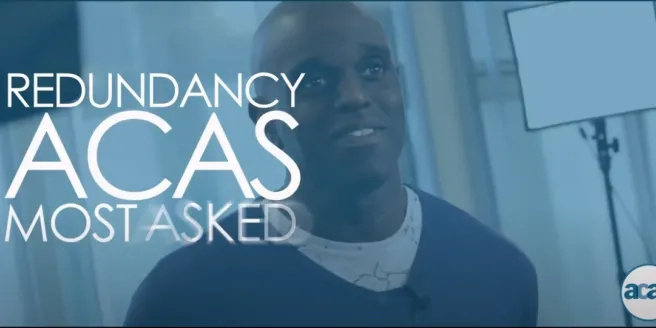Find Help
More Items From Ergsy search
-

Redundancy Coaching Couch 7: Redundancy and Judgement.MTS
Relevance: 100%
-

Redundancy Coaching Couch 4:Redundancy and Language
Relevance: 100%
-

Redundancy Coaching Couch 5: Redundancy and Feedback.MTS
Relevance: 99%
-

Redundancy Coaching Couch 1: Redundancy and Presuppositions
Relevance: 99%
-

Redundancy Coaching Couch 2: Redundancy and Passion
Relevance: 98%
-

Redundancy Crusader and Annabel Kaye on communications in redundancy (5).MTS
Relevance: 95%
-

Redundancy Crusader and Annabel Kaye on scope and scale of redundancy (3).MTS
Relevance: 94%
-

Redundancy Crusader and Annabel Kaye on the Current Model of Redundancy (1).MTS
Relevance: 93%
-

Redundancy Crusader and Annabel Kaye on making redundancy a better experience (2).MTS
Relevance: 92%
-

Redundancy Coaching Couch 3: States
Relevance: 89%
-

HOW A REDUNDANCY WORKS - General Information
Relevance: 87%
-

Frequently asked questions about redundancy from ACAS
Relevance: 82%
-

Understanding Your Rights: Legal Support for Families During Economic Turbulence
Relevance: 26%
-
Do new variants affect COVID-19 testing?
Relevance: 18%
-

What is the deadline for filing a tribunal application?
Relevance: 13%
-

What if my circumstances change?
Relevance: 12%
-

Am I considered an employee if I am a gig worker?
Relevance: 12%
-

Is job security a right for gig workers?
Relevance: 12%
-

What is a food bank?
Relevance: 12%
-

Upcoming Changes to Parental Leave Policies in the UK
Relevance: 12%
-

Why did I receive a tax refund letter from HMRC?
Relevance: 12%
-

Boost your Take Home Pay | Salary Sacrifice Explained UK
Relevance: 9%
-

What does the disbandment of NHSE mean for me?
Relevance: 7%
-

How can primary care support workers contribute to patient care improvement?
Relevance: 6%
Understanding the Scope and Scale of Redundancy: Insights by Redundancy Crusader and Annabel Kaye
Introduction to Redundancy in the UK
The issue of redundancy is a critical concern in the United Kingdom’s employment landscape. As companies undergo restructuring, the challenge of handling redundancies with utmost fairness and legality becomes paramount. In this context, Redundancy Crusader and Annabel Kaye have been pivotal figures, providing insightful guidance and support to both employers and employees. Their perspectives highlight the multifaceted nature of redundancy, emphasizing not just compliance with legal frameworks but also the human elements involved in the process.
Scope of Redundancy
The scope of redundancy encompasses a wide range of scenarios, from economic downturns and technological advancements to business mergers and acquisitions. Redundancy Crusader, a well-known advocate for employee rights, states that understanding the various triggers for redundancy is crucial for both parties involved. By comprehending the different situations that can lead to redundancy, employees can better prepare for potential job losses, while employers can devise more strategic plans to minimize workforce disruption.
Annabel Kaye, an expert in employment law, echoes this sentiment by pointing out that redundancy isn't just a cost-cutting measure. It often reflects an organization's need to adapt to changing market conditions. Kaye underscores the importance of clear communication and thorough planning to ensure that the redundancy process is transparent, equitable, and legally sound.
Scale of Redundancy
The scale of redundancy can vary significantly, from small-scale layoffs affecting a handful of employees to large-scale operations that impact entire departments or even whole industries. Redundancy Crusader emphasizes that the implications of redundancy on this scale require meticulous planning and a keen awareness of the potential socio-economic consequences. For larger organizations, this often means having comprehensive contingency plans and support systems in place to assist affected employees.
Annabel Kaye advises that regardless of the scale, each redundancy case should be handled on an individual basis, considering the specific needs and circumstances of the employees involved. Tailoring redundancy packages, offering retraining opportunities, and providing psychological support are some of the measures she advocates to mitigate the adverse effects on redundant workers.
Conclusion
In the UK, redundancy continues to be a complex and often challenging aspect of the employment landscape. Through the dedicated work of figures like Redundancy Crusader and Annabel Kaye, there is growing awareness and better strategic management of redundancy processes. By addressing both the scope and scale of redundancy, these experts provide invaluable insights that help protect employees' rights and foster more resilient business practices.
Understanding Redundancy: Insights by Redundancy Crusader and Annabel Kaye
What is Redundancy in the UK?
Redundancy means losing your job because the company no longer needs your role. This is a big issue in the UK. When companies change, they must be fair and follow the law when letting people go. Redundancy Crusader and Annabel Kaye are experts who help businesses and workers with redundancy. They say it's important to follow the law and think about how people feel when they lose their jobs.
Why Redundancy Happens
There are many reasons why redundancy happens. It can be because of money problems, new technology, or companies joining together. Redundancy Crusader, who supports workers' rights, says understanding these reasons helps everyone get ready for possible job losses. Workers can prepare, and companies can plan better to avoid too much disruption.
Annabel Kaye, who knows a lot about employment law, says redundancy is not just about saving money. It often happens because businesses need to change with the market. She stresses the importance of talking openly and planning well to make the process fair and legal.
How Redundancy Can Affect People
Redundancy can affect a few people or many, depending on the situation. Redundancy Crusader says big redundancies need careful planning because they can affect communities and industries. Big companies need to have backup plans to help workers who lose their jobs.
Annabel Kaye advises that each redundancy should be personal. This means thinking about what each person needs. She suggests giving help, like retraining for new jobs and emotional support, to make things easier for people who lose their jobs.
Final Thoughts
In the UK, redundancy is a tricky and important issue for work. Experts like Redundancy Crusader and Annabel Kaye help people understand it better. They show how to handle redundancy well to protect workers and support businesses. Understanding why redundancy happens and how it affects people helps create better workplaces.
Frequently Asked Questions
What is redundancy?
Redundancy occurs when an employer reduces their workforce because a job or jobs are no longer needed, not due to the performance or conduct of individuals.
What are the legal requirements for redundancy in the UK?
In the UK, employers must follow a fair process, including consultation with employees, offering suitable alternative employment if possible, and providing statutory redundancy pay based on length of service, age, and weekly pay.
How is redundancy pay calculated?
Statutory redundancy pay is calculated based on age, length of continuous service with the employer, and weekly pay. It is capped at 20 years of service and the weekly pay is capped at a statutory maximum.
What is the notice period for redundancy?
Notice periods depend on the length of continuous service: one week for each year of service up to a maximum of 12 weeks.
Can an employee be selected for redundancy based on performance?
Employees should not be made redundant based on performance or conduct. Redundancy should be due to the role being no longer needed.
What is a consultation period in redundancy?
A consultation period is a mandatory process where employers discuss the reasons for redundancies, consider alternatives, and engage with employees or their representatives.
Is an employee entitled to redundancy pay if they refuse alternative employment?
If the alternative employment offered is suitable and the employee unreasonably refuses it, they may forfeit their right to redundancy pay.
What is a suitable alternative employment?
Suitable alternative employment is a job offer that is substantially similar in terms, conditions, and responsibilities to the employee's previous role.
Can employers make redundancies if the business is not in financial trouble?
Yes, redundancies can be made if the employer needs to reorganize, restructure, or if certain job functions are no longer necessary, not just due to financial issues.
What are ‘at risk’ letters?
‘At risk’ letters inform employees that they are at risk of redundancy. It usually opens the consultation process.
What kind of support might employers offer during redundancy?
Employers may offer support such as outplacement services, counseling, retraining programs, or time off to attend interviews.
Can redundancy be challenged or appealed?
Yes, employees can challenge or appeal if they believe the redundancy process was unfair or if they were discriminated against.
How does collective redundancy differ from individual redundancy?
Collective redundancy occurs when 20 or more employees are made redundant within a 90-day period. Specific rules, including minimum consultation periods, apply.
What is the role of trade unions in redundancy?
Trade unions can represent employees in redundancy consultations, negotiate on behalf of their members, and ensure fair processes are followed.
What happens if an employer does not follow redundancy procedures?
Failure to follow proper redundancy procedures may result in claims of unfair dismissal, and employers could be required to pay compensation or reinstate employees.
What does redundancy mean?
Redundancy is when you lose your job because your employer does not need your job position anymore. It's not because you did something wrong.
If you are made redundant, there are things that can help, like getting support from a job advisor or looking for new jobs online.
It is important to talk to someone you trust about how you feel if you are made redundant.
Redundancy happens when a boss decides there are too many jobs and not all are needed anymore. It is not because someone did anything wrong or is not working well.
What are the rules for losing your job in the UK?
Here are some simple steps and tools to help understand:
- When someone loses their job because the company is changing or closing, it is called "redundancy".
- The boss must give a good reason for letting someone go.
- The boss must talk with the person before making a decision.
- The person should get a notice period, which is a warning time before they have to leave.
- The person may get some extra money when they leave, called "redundancy pay".
If you find it hard to read, you can use:
- A friend or family member to help explain.
- An online tool that reads the words out loud.
In the UK, when people lose their jobs, bosses must be fair. They need to talk with the worker about it. If the person can do another job, the boss should try to give them a new one. People also get money when they lose their job. This money depends on how long they worked, how old they are, and how much they earn each week.
How do you work out redundancy pay?
When a job ends because there is no work, you might get money. This is called redundancy pay.
Here is a simple way to see how much money you can get:
- Know how many years you worked at the job.
- Think about how old you are now.
- Look at the rules that say how much money your job gives for each year.
You can get help from these tools:
- Ask someone at work to help you understand.
- Use a calculator to add up the money.
Redundancy pay is money you get if you lose your job because there is no work. It depends on how old you are, how long you have worked at your job, and how much you earn each week. You can only count up to 20 years of work. There is also a limit to how much weekly pay you can use to work out the money.
How long before a job ends do you get told?
How long you have to wait before leaving a job depends on how long you have worked there.
You wait 1 week for each year you worked there.
The most you will wait is 12 weeks.
Can someone lose their job because they are not doing well at work?
Sometimes, a company needs to let some people go. This can happen if things are not going well with the business. When choosing who will leave, a person can be picked if they are not doing a good job.
If someone is told they might lose their job, they can ask questions. It's a good idea to talk about how well they are doing their job. They can also ask for help to get better at work.
Speaking with a friend or getting advice from someone who helps with jobs can be useful.
Workers should not lose their jobs because of how they work or how they behave. Jobs should only end if the job is no longer needed.
If you find reading hard, try these tips:
- Ask someone to read with you.
- Use a highlighter to mark important words.
- Take breaks if you get tired.
What is a consultation period in redundancy?
A "consultation period" is a time to talk and listen. It happens when a company needs to let people go, called redundancy. During this time, the company and workers talk about why it's happening and how it affects everyone.
The company gives workers a chance to share their thoughts and ideas. They can ask questions and talk about any worries they have. This helps everyone understand what's going on.
Some tools can help with understanding, like pictures or simple charts. You can also ask a friend or someone you trust to explain things if it's hard to understand.
A consultation period is a time when bosses must talk to their workers. They must say why they are letting people go, think about other options, and listen to what workers or their helpers have to say.
Do you get redundancy pay if you say no to a new job offer?
If your job is ending, your boss might offer you a new job.
If you say no to the new job, can you still get pay for losing your old job?
Here are some tools to help:
- A friend or family member can help you read and understand.
- Use colored pens to highlight important words.
- Ask your boss or a trusted person to explain things to you.
If your job changes and you get a new job offer that is good for you, but you say no without a good reason, you might not get your extra money when leaving your job.
What is another job that is good for you?
A suitable job offer is a new job that is a lot like the old job in how it works and what the worker has to do.
Can bosses let workers go if the business is not losing money?
Bosses might decide to let workers go even if the business is not losing money. This is called "redundancy." It can happen if the business changes how it works. For example, they might get new machines to do the work or change the way they deliver services.
Here are some tips to understand more:
- Ask someone you trust to explain big words.
- Use a dictionary to look up words you don't know.
- Talk to a worker's helper or a union person if you need advice.
Yes, sometimes people lose their jobs when a company changes how it works or does not need certain jobs anymore. This can happen even if the company is not losing money.
What are 'at risk' letters?
'At risk' letters are letters that tell you something important. They say you might need help or be in danger. This letter will tell you what to do next.
If you get an 'at risk' letter, you can talk to someone you trust. This could be a family member, a friend, or a teacher.
To help understand the letter better, you can use tools like a dictionary or ask someone to read it with you.
"At risk" letters tell workers they might lose their jobs. This starts a talking process about it.
How can bosses help when you lose your job?
Bosses can help by giving you special support. They might help you find a new job, talk to someone who can help, learn new skills, or give you time to go to job interviews.
Can I say it’s unfair if I lose my job?
Yes, workers can speak up if they think losing their job was not fair or if they feel they were treated badly.
What is the difference between group job loss and single job loss?
When a group of people from one place lose their jobs at the same time, it is called group job loss.
When only one person loses their job, it is called single job loss.
Group job loss is about many workers, while single job loss is about one worker.
A good tool to help understand these ideas is using pictures or diagrams.
Collective redundancy happens when 20 or more workers lose their jobs in 90 days. There are special rules and time for talking that must happen.
What do trade unions do when people lose their jobs?
Trade unions help workers when there are job cuts. They talk to bosses for the workers, make sure everything is fair, and follow the rules.
What if a boss does not follow the rules when they need to let people go?
If a company does not follow the right steps when letting people go, it might have to pay them money or give them back their jobs. This is called unfair dismissal.
Useful Links
- Ergsy carfully checks the information in the videos we provide here.
- Videos shown by Youtube after a video has completed, have NOT been reviewed by ERGSY.
- To view, click the arrow in centre of video.
- Most of the videos you find here will have subtitles and/or closed captions available.
- You may need to turn these on, and choose your preferred language.
- Go to the video you'd like to watch.
- If closed captions (CC) are available, settings will be visible on the bottom right of the video player.
- To turn on Captions, click settings .
- To turn off Captions, click settings again.
More Items From Ergsy search
-

Redundancy Coaching Couch 7: Redundancy and Judgement.MTS
Relevance: 100%
-

Redundancy Coaching Couch 4:Redundancy and Language
Relevance: 100%
-

Redundancy Coaching Couch 5: Redundancy and Feedback.MTS
Relevance: 99%
-

Redundancy Coaching Couch 1: Redundancy and Presuppositions
Relevance: 99%
-

Redundancy Coaching Couch 2: Redundancy and Passion
Relevance: 98%
-

Redundancy Crusader and Annabel Kaye on communications in redundancy (5).MTS
Relevance: 95%
-

Redundancy Crusader and Annabel Kaye on scope and scale of redundancy (3).MTS
Relevance: 94%
-

Redundancy Crusader and Annabel Kaye on the Current Model of Redundancy (1).MTS
Relevance: 93%
-

Redundancy Crusader and Annabel Kaye on making redundancy a better experience (2).MTS
Relevance: 92%
-

Redundancy Coaching Couch 3: States
Relevance: 89%
-

HOW A REDUNDANCY WORKS - General Information
Relevance: 87%
-

Frequently asked questions about redundancy from ACAS
Relevance: 82%
-

Understanding Your Rights: Legal Support for Families During Economic Turbulence
Relevance: 26%
-
Do new variants affect COVID-19 testing?
Relevance: 18%
-

What is the deadline for filing a tribunal application?
Relevance: 13%
-

What if my circumstances change?
Relevance: 12%
-

Am I considered an employee if I am a gig worker?
Relevance: 12%
-

Is job security a right for gig workers?
Relevance: 12%
-

What is a food bank?
Relevance: 12%
-

Upcoming Changes to Parental Leave Policies in the UK
Relevance: 12%
-

Why did I receive a tax refund letter from HMRC?
Relevance: 12%
-

Boost your Take Home Pay | Salary Sacrifice Explained UK
Relevance: 9%
-

What does the disbandment of NHSE mean for me?
Relevance: 7%
-

How can primary care support workers contribute to patient care improvement?
Relevance: 6%


